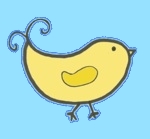

Research from another laboratory recently showed that 7-month-olds were unable to learn an AAB or ABB pattern (with repetition at the beginning or end) when the pattern was produced with musical notes, but they could learn the pattern when it was produced with syllables. Does this finding mean that there is something special about language? Or could it be that experience with music makes repetition less noticeable. For example, most music is "smooth", so that if you're hearing one note, the next note is likely to be either the same or just one step up or down. If babies have learned about the smoothness of music, they may come to believe that there is nothing special about repetition, because it is just part of the musical system. This view suggests that babies who have not yet heard enough music to infer the smooth structure may find repetition more interesting and therefore learnable. To test this suggestion, we tested 4-month-olds on the AAB and ABB musical patterns that had eluded 7-month-olds in the earlier study. Counter to the claim that there is something special about language, they learned these patterns easily!
Variety in the input might help language production. Four-year-olds listened to new words that were played either once or ten times. The words played ten times were either produced by the same person or by ten different people. When children were asked to say the words, they were better at producing the words that they had heard ten times, but only if the words had been produced by ten different people.
A number of researchers, including the famous Noam Chomsky, have suggested that babies might be biased to learn patterns that occur in real languages. Languages of the world have many rules about which syllables in words should be stressed. Many languages have a rule that syllables ending in a consonant should be stressed. No languages have a rule that says that syllables starting with 't' should be stressed. Consistent with that suggestion, research from our lab has shown that 9-month-olds are able to quickly learn the 'ends in consonant' rule, but not the other rule. However, we have also found that younger babies (7-month-olds) are able to learn the rule that does not occur in human languages. Therefore, it appears that the forms languages take are shaped by what is easy for language users to perceive and produce, and do not come "prewired" in babies.
Click here to download the original Language Learning and Development article.
Three-year-old children typically don't seem aware of their own knowledge states--they tend to be overconfident when they predict their own performance, for example, saying they are the fastest runner, or know all the matches. In our studies, three-and-a-half year old children learned a set of matching pairs and were asked to indicate which ones they knew (remembered) and which ones they didn't know (forgot), not by telling us with words but by showing us by pointing. Using this type of response, children were able to differentiate between remembered and forgotten matches, thus indicating some awareness of their knowledge states. This suggests that children may begin to understand their thoughts before they show conscious awareness of them by talking about them. This further suggests that children, and possibly infants, may be able to use sophisticated strategies, like memory monitoring, to guide how they learn at much younger ages than has been traditionally thought.
Click here to download the original Developmental Science article.
One mystery about how babies learn is how they choose the learning problems to tackle in the first place. In any given situation, a baby could focus on any number of aspects of the environment to explore. How do they avoid wasting their time by focusing on aspects where there is nothing to learn, or learning problems that they are not yet ready to solve? Recent research from our lab suggests that infants are able to detect whether or not they are learning and pay more attention to aspects of their environment that are learnable. We let 17-month-olds listen to a language that other babies had learned or to one that other babies (and adults) found impossible to learn. When babies showed that they were no longer interested, the experiment ended. The babies who heard the learnable language listened much longer than the other group and began showing increased interest after they had heard only about 45 seconds of the language. Infants in the earlier study who were tested on their learning, not on their interest level, took about 3 minutes to learn the language. Therefore, it seems that babies know they're making progress on a learning problem in much less time than it takes them to actually solve the problem.
Nine-month-old infants listened for 2 min. to 3-syllable 'words' with an AAB pattern, in which the first syllable repeats (e.g., laylaydee, weeweejay, etc.). The words either had another pattern embedded or not. The embedded pattern was that all of the words ended in the syllable 'dee'. Infants who heard the words without the embedded pattern were able to recognize as familiar new AAB words when we tested their interest. But infants who heard words with the embedded pattern were only able to recognize new words with the embedded pattern, not the more general AAB pattern (Gerken, 2006). In a later study, just 3 examples of words that had just the more general AAB pattern mixed in with the embedded pattern were enough to cause infants to recognize new words with the more general AAB pattern. This result suggests that they were considering both patterns all along and just needed a little evidence to tip them from favoring the embedded pattern to the more general pattern.